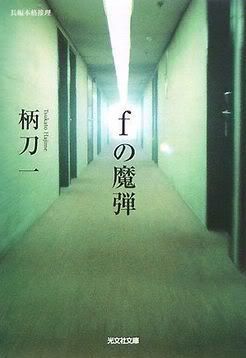 Hamasaka Kazuya is found in a completely locked apartment together with two corpses; the gun lying beside him and with gunpowder residue on his clothes. Even though Kazuya seems to hide something, he claims false accusation and asks his advocate to call for his old friend Minami Mikikaze whom he expects to solve this case. However after seeking out a person in America who seems to be related to the two victims, Mikikaze himself gets caught in a similar locked room scenario...
Hamasaka Kazuya is found in a completely locked apartment together with two corpses; the gun lying beside him and with gunpowder residue on his clothes. Even though Kazuya seems to hide something, he claims false accusation and asks his advocate to call for his old friend Minami Mikikaze whom he expects to solve this case. However after seeking out a person in America who seems to be related to the two victims, Mikikaze himself gets caught in a similar locked room scenario...Yes, you could call this a contemporary adaption, or rather reimagining, of Carter Dickson's (John Dickson Carr's) The Judas Window. Despite the allusions it does not spoil Carr's masterpiece though and having read said book does not spoil this recent novel either. For me it rather fueled my interest, as I've really liked the original scenario by Carr where a falsely accused person and a corpse are found together in a locked room, but the original's plot lacked a certain drive and spark for me as it mostly consisted of courtroom scenes.
f no madan also features those but that mainly serves the purpose of illustrating the crime scene and the crime's circumstances. On the one hand the narrative is composed of the past which includes the story of crime, the first courtroom scenes and the essential investigations and character introductions and on the other hand the present time where Mikikaze is trapped in a similar crime scene himself. Those two partial narrative take turns and intertwine in the solution and the plot's finale which certainly makes for a comparatively enthralling read.
Personally I think the book could have been a bit shorter, but the focuses on the different characters connected the locked room + false accusation setting to a general theme of urban anxiety and security issues, various forms of social injustice and the perpetual role allocation of transgressor and victim, so I guess the length is somewhat justified. I won't spoil to which extent this novel alludes to The Judas Window's trick but I'll give the hint that a similar gimmick is also featured here and it's much more symbolic in the thematic context of Tsukatou Hajime's novel.
So the finale definitely compensated for the slower parts but I have to admit that the solution might seem a little too "programmed" for some readers, which is something I often read in reviews of Tsukatou's novels. However the fact that the trick is constructed so carefully yet precariously could also be seen as a hint at the culprit if that person wouldn't have been so brazenly inconspicious. The motive isn't that fascinating either but maybe I shouldn't have expected much in a shakaiha-like setting with drug dealing and yakuza and stuff... The trick itself is fairly guessable once the gimmick is explained. I don't know how anyone could come up with the latter though but that wasn't different with Merrivale's Judas window which was supposed to exist in almost any room...
This novel proved that orthodox tricks can be enbedded in modern, urban settings just as well and even if the locked room might be a tad too constructed and lacking in terms of realism and details it turned out as a recommendable example of neo-orthodox spirit and personally I was left satisfied after finishing this book. Classical detectives like Minami Mikikaze are destined to keep up with the times. The next Tsukatou I read will definitely be a short story collection though as those seem to be prevalent in his bibliography, which might indicate why this longer novel felt a bit too slow and long to me...
No comments:
Post a Comment